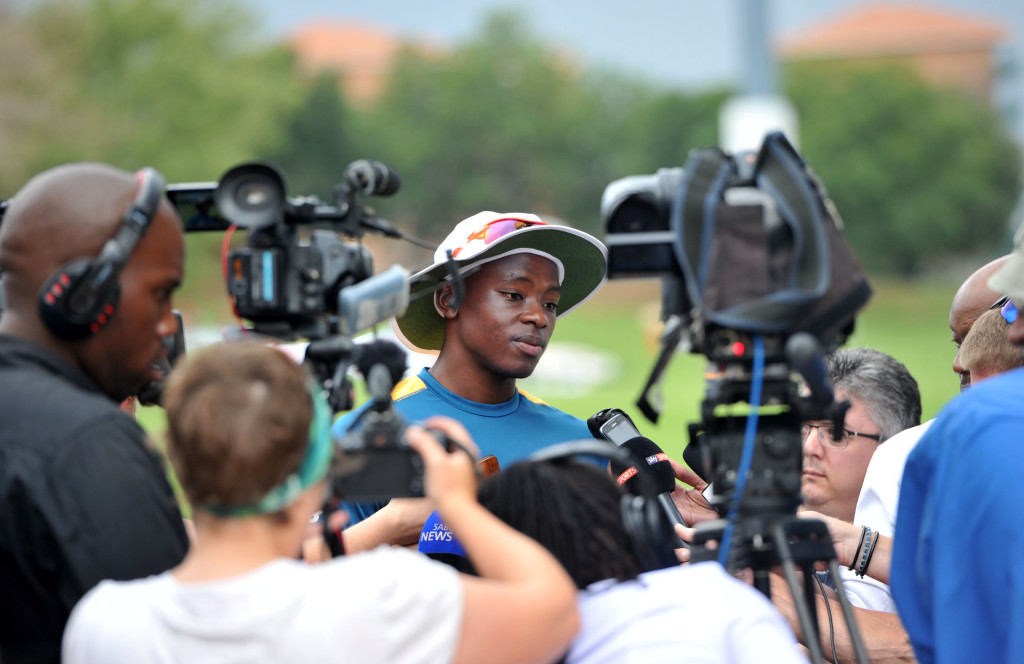Kagiso Rabada is not only a winner on the field but more importantly off it as well.
‘Hey KG, it’s Michael. You signed my Sunfoil six scoresheet. I just want to say thank you so much, you’re a real hero to me and good luck in your upcoming matches.’
I played the above audio clip to Kagiso Rabada while he was preparing for a cover photo shoot for SA Cricket magazine. ‘Wow!’ was his reply. It was 19 February this year. Seven weeks earlier the then 13-year-old fan had waited at the fine-leg fence on the opening day of the New Year’s Test against England at Newlands for a Proteas player, any player, to sign an autograph.
Rabada, then 20, had been the first, and only one, on a difficult opening morning for the home side to take the time to engage in that way with the fan. I later made a point of asking Michael, how he felt about KG’s signature as he was visibly elated at the interaction. And I recorded him, and played it back to Rabada when I had the opportunity.
I asked Rabada if he could remember the last time he asked for, and received, an autograph. He thought for a while and then said, ‘Ashwin Willemse. It was at a Lions game at Ellis Park.’
Rabada was 14 when he got his last signature from a hero. Look where he is now. Michael, now 14, might not play for the Proteas or Springboks, but he is going on a cricket tour to Knysna for his school in the fourth term. The autograph helped him to aspire.
Never underestimate the power a ‘simple’ autograph carries to someone who looks up to a hero.
Kagiso Rabada is now a national hero. He’s only 21 and soon he will be an international hero. He might even become one of the greatest bowlers cricket has ever seen. Then again, maybe he won’t. In sport, as in life, there are no guarantees. But the foundations and signs are there that for the next decade he will be a leading light in the sport – and a household name.
He won a record six awards at the Cricket SA banquet and one of them was Fans’ Player of the Year. Given the above example, there could never have been anyone else.
Test cricketer of the Year? Yup. ODI Cricketer of the Year? Of course. Players’ Player of the Year? In a year in which the Proteas were actually overall poor and the big guns went missing by their lofty standards, Rabada kept the dressing room bouncing. Delivery of the Year? Ask Jason Roy how he felt about that one in the T20I match at the Wanderers.
SA Cricketer of the Year? It was a no contest. The young man cleaned up. I’m actually surprised that he was beaten by Temba Bavuma to the ‘KFC So Good’ award. Whatever the criteria, no player other than Rabada made South Africa feel so good all year – and that is with complete respect and admiration for what Bavuma achieved by becoming the first black South African to score a Test hundred, ironically in the same Test that Rabada had caught the eye as a fan’s favourite.
No one can argue with Imran Tahir being named T20 International Player of the Year. The other award Rabada didn’t win was International Newcomer of the Year. Aged 21, he wasn’t eligible, which shows how far he has come already. Instead it went to Stephen Cook, who scored a hundred in his debut, and so far only, Test. At the age of 33, mind you. Chuckle chuckle, egg on the faces of the national selectors perhaps?
The awards came on the night that hours earlier Cricket SA had announced they would be formally implementing quotas in the Proteas – predictably stopping short of putting a number to it. I smiled at the irony, given only one white, the 33-year-old Cook, had been named among the nine main awards made available to the men.
One has to again ask the question. If enough is being done at the lower structures, will enforced quotas at the highest level improve the Proteas? I would have thought the answer would have come from CSA’s own awards evening. Was it not a joyous celebration of talent, as opposed to colour?
Kagiso Rabada is 21 and black. Temba Bavuma is 26 and black. Dane van Niekerk, Women’s Cricketer of the Year, is 23 and white. Imran Tahir, is now 37. He was born in Lahore and played for Pakistan in the U19 World Cup. Stephen Cook is 33 and white.
Should all of them be looking in the mirror and being reminded of their skin colour? The 14-year-old fan, Michael, is white, but I’m willing to bet you he doesn’t understand what the word ‘quota’ means.
In my mind, all of those who represent South Africa on merit are winners, although Rabada is the biggest, not necessarily for what he did on the field to win him the awards, but for the inspiration that he already is to a nation of people who just want to feel good about being South African.
Photo: BackpagePix





